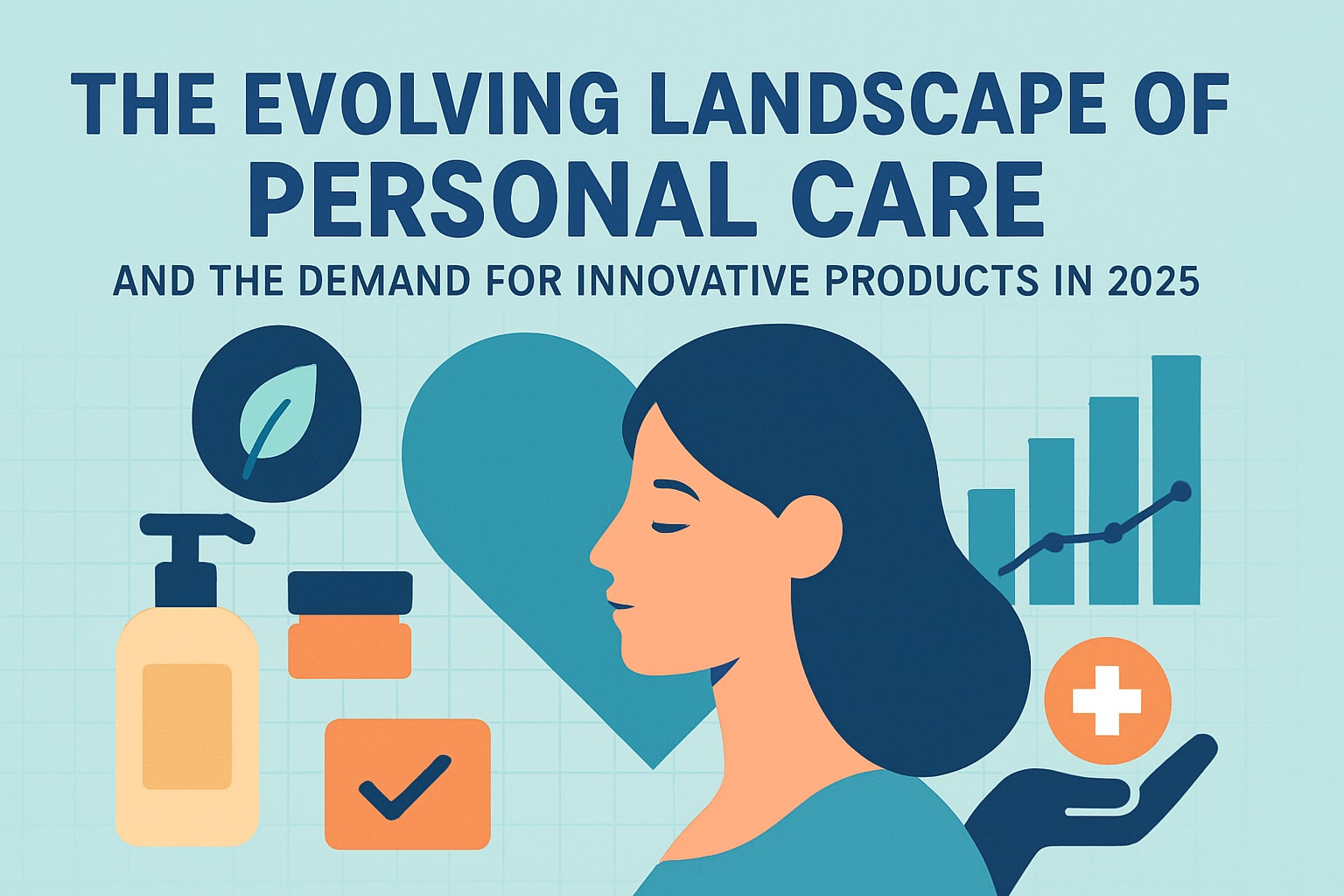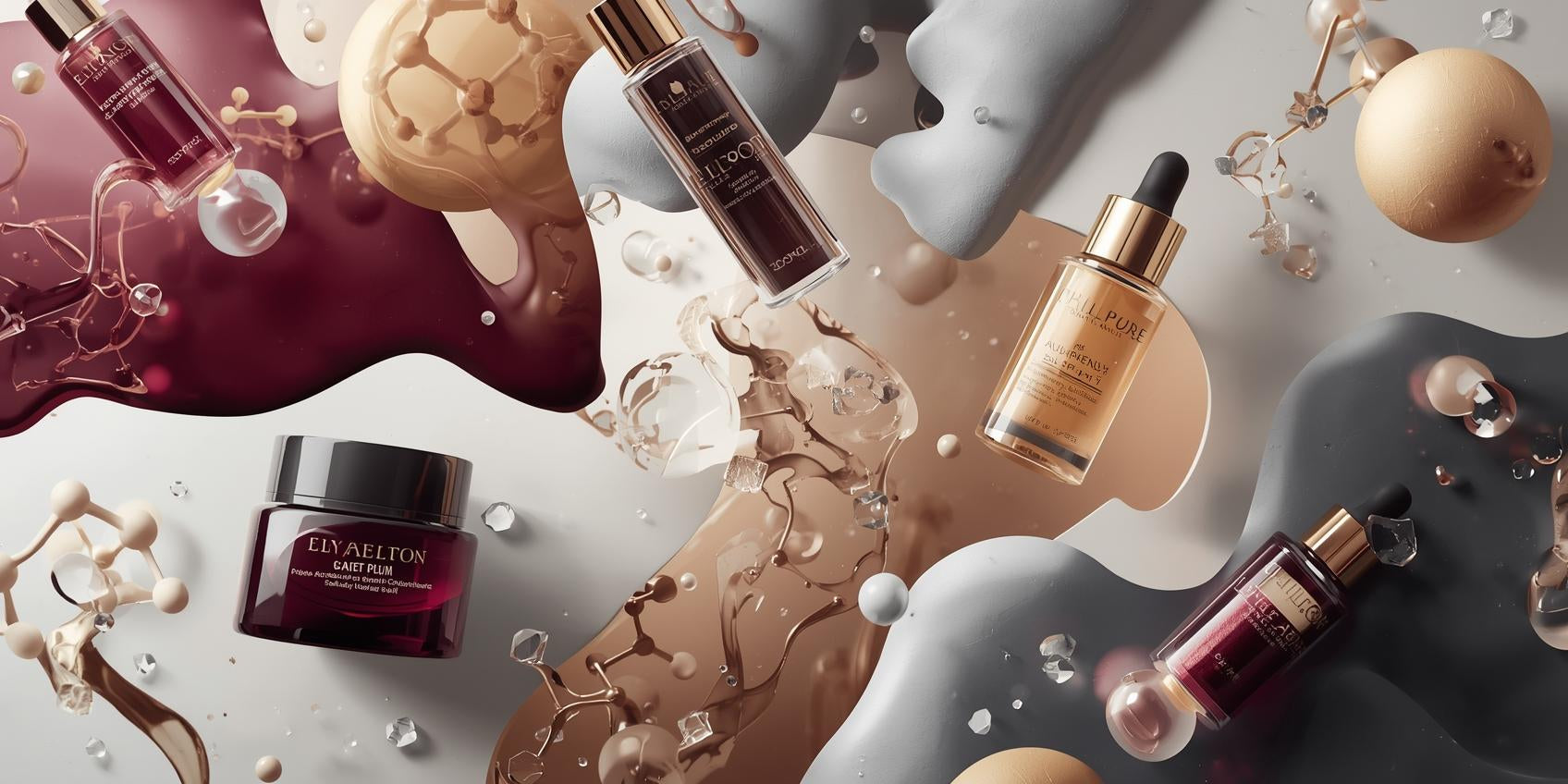The global skincare industry is experiencing unprecedented growth, with private label skincare at the forefront of innovation and opportunity in 2025. Entrepreneurs and established brands alike are capitalizing on this momentum to create unique, profitable ventures.
This comprehensive guide is designed to empower you with the knowledge and tools needed to launch, scale, or optimize a private label skincare business in today’s evolving landscape. You will discover the latest market trends, step-by-step processes, smart product selection, branding strategies, regulatory essentials, and future opportunities.
Are you ready to learn how private label skincare can unlock new revenue streams and set your brand apart? Dive in for actionable insights that will help you turn ambition into measurable success.
Understanding Private Label Skincare in 2025
The world of private label skincare is rapidly evolving, offering brands and entrepreneurs a unique opportunity to enter the booming beauty market with agility and confidence. Understanding the fundamentals and the forces shaping this sector in 2025 is crucial for anyone aiming to succeed.
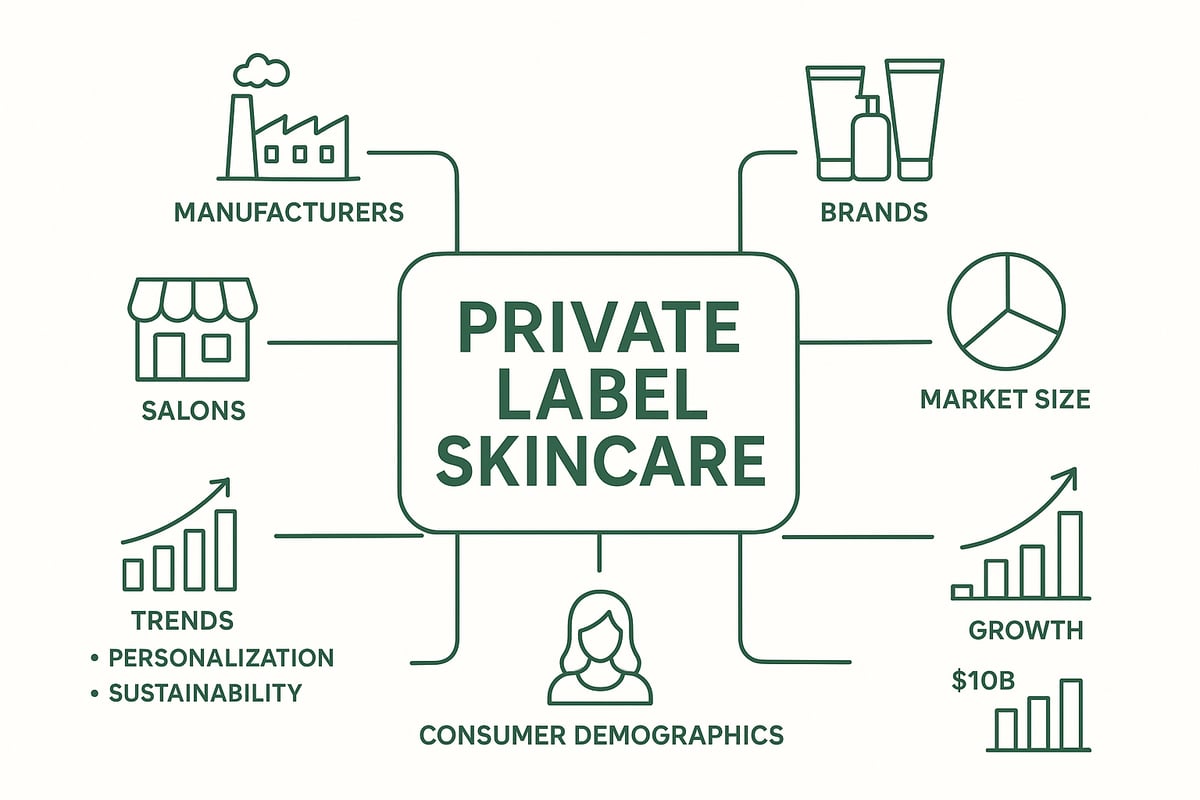
What is Private Label Skincare?
Private label skincare refers to products that are manufactured by one company and then branded and sold by another. Unlike white label, where generic products are offered to multiple brands with minimal customization, private label skincare allows for greater control over formulation, packaging, and branding. Custom manufacturing, on the other hand, involves developing unique products from scratch, which can require more time and investment.
Some of the most successful beauty brands today have built their reputations through private label skincare. These brands leverage the expertise and facilities of established manufacturers to bring high-quality products to market quickly, often with lower startup costs and reduced risk.
Key benefits of private label skincare include:
| Benefit | Description |
|---|---|
| Speed-to-market | Launch products faster by using existing formulas |
| Cost efficiency | Lower R&D and manufacturing costs |
| Flexibility | Adapt quickly to trends and consumer demand |
Recent industry data shows the global private label skincare market is experiencing double-digit growth, with projections indicating continued expansion through 2025. According to The rise of private label skincare, this surge is driven by increased consumer trust in boutique brands and a demand for more personalized products.
Key players in the ecosystem include contract manufacturers, ingredient suppliers, packaging designers, and brand owners. Private label skincare serves a wide range of businesses, from salons and spas to e-commerce entrepreneurs and established retailers, each seeking to offer unique products without investing in their own production facilities.
Why Private Label Skincare is Booming in 2025
Several factors are fueling the rapid growth of private label skincare in 2025. Consumers are gravitating toward indie and boutique brands that offer authenticity, transparency, and innovation. Social media and influencer marketing have made it easier for new brands to reach niche audiences and build loyal communities.
Direct-to-consumer models are reshaping how skincare is sold, allowing brands to connect with buyers online and deliver a personalized experience. Customization and personalization are now expected, with advanced technologies making it possible to tailor products to individual skin types and concerns.
Sustainability has become a non-negotiable standard for many shoppers. Brands that prioritize ethical sourcing, eco-friendly packaging, and cruelty-free practices are gaining a competitive edge. The accessibility of advanced formulations and innovative packaging options means that even startups can offer products that rival established luxury brands.
For salons, spas, and entrepreneurs, private label skincare offers a pathway to diversify revenue streams and strengthen brand loyalty. As the market continues to expand, those who understand and capitalize on these trends will be well positioned for long-term success.
Step-by-Step: How to Launch a Private Label Skincare Brand
Entering the private label skincare market in 2025 offers brands and entrepreneurs remarkable opportunities for growth and innovation. To ensure your journey is both strategic and successful, follow this five-step process designed for today’s competitive landscape.
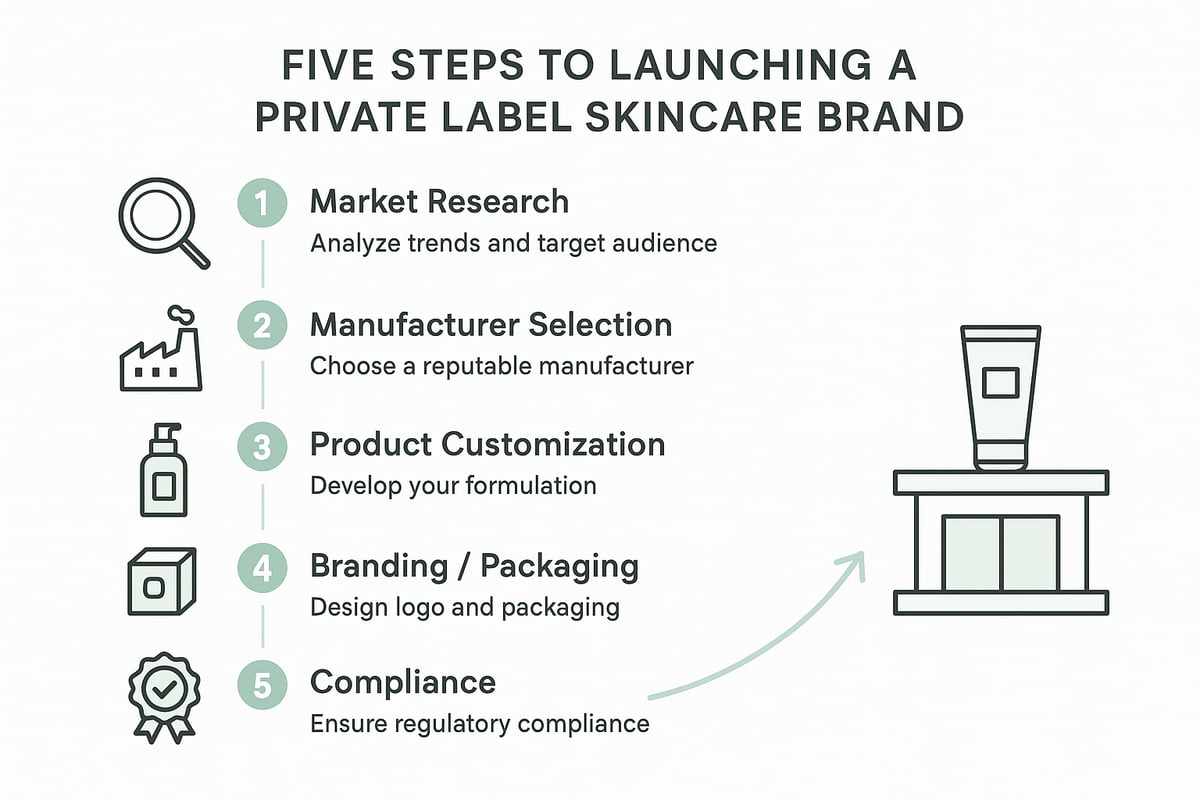
Step 1: Market Research and Brand Positioning
Begin by defining your target market and unique value proposition. Study the demographics, preferences, and pain points of your ideal customers. Analyze competitors to identify gaps and emerging trends in private label skincare.
Determine what sets your brand apart. Are you focusing on eco-friendly solutions, clinical-grade actives, or perhaps a specific skin concern? For instance, brands that specialize in vegan or dermatologist-tested products have carved out profitable niches.
Summarize your findings in a table for clarity:
| Element | Details/Example |
|---|---|
| Target Audience | Gen Z with sensitive skin |
| Key Trend | Sustainable packaging |
| Unique Selling Point | Fragrance-free, hypoallergenic |
A clear positioning strategy is the foundation for private label skincare success.
Step 2: Choosing the Right Private Label Manufacturer
Selecting a manufacturing partner is a critical step. Look for manufacturers with proven experience, necessary certifications (such as GMP or ISO), and robust support services. Minimum order quantities (MOQs), ingredient sourcing, and responsiveness should align with your business goals.
Ask questions about formulation capabilities, lead times, and transparency in operations. Request sample kits to evaluate product quality and ensure consistency. For an in-depth checklist and expert tips, explore this guide to choosing the best skincare manufacturer.
Building a strong relationship with your manufacturer will support your private label skincare brand’s growth and reputation.
Step 3: Product Selection and Customization
Decide which product categories will anchor your line. Popular choices in private label skincare include cleansers, serums, moisturizers, and masks. Customization options such as fragrance, active ingredients, and packaging design allow you to tailor products to your audience.
Balance innovation with proven, in-demand formulations. In 2025, consumers favor ingredients like hyaluronic acid, niacinamide, and peptides. Use data to prioritize best-sellers and consider seasonal or limited-edition launches.
Testing samples and gathering feedback ensures your products meet expectations and stand out in the private label skincare marketplace.
Step 4: Branding and Packaging Design
Develop a compelling brand identity that resonates with your target audience. Consistency in logo, color palette, and messaging builds recognition and trust. Stay current with packaging trends—sustainable materials, minimalist aesthetics, and luxury finishes are particularly popular in private label skincare.
Ensure your packaging meets regulatory requirements for ingredient disclosure and safety warnings. Brands that excel in creative, compliant packaging often enjoy higher shelf appeal and customer loyalty.
Review case studies of successful packaging strategies to inspire your own private label skincare launch.
Step 5: Regulatory Compliance and Safety
Navigate the regulatory landscape with care. Familiarize yourself with key regulations in major markets such as the US, EU, and Asia. Ingredient transparency, allergen disclosure, and accurate labeling are essential for private label skincare.
Invest in product testing and seek certifications like cruelty-free, vegan, or organic to enhance your brand’s credibility. Reliable resources and industry associations can help you stay updated on evolving standards.
By prioritizing compliance and safety, you protect your business and build lasting trust with private label skincare customers.
Trends Shaping Private Label Skincare in 2025
The private label skincare market is undergoing rapid transformation in 2025, driven by innovation and evolving consumer expectations. Brands must stay ahead of these dynamic trends to succeed in a competitive environment. Understanding the major forces at play is essential for anyone looking to launch or scale a private label skincare brand.
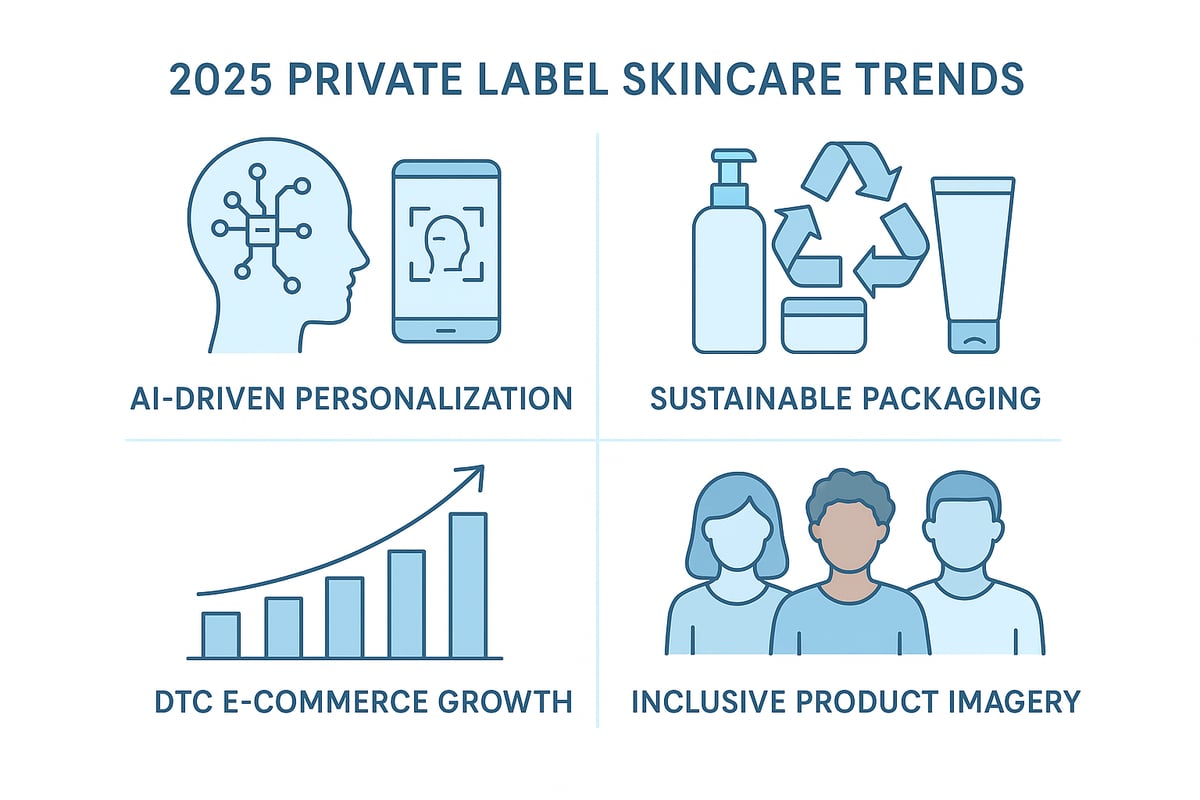
Personalization and Advanced Formulation Technologies
In 2025, personalization is a defining trend in private label skincare. Brands are leveraging AI-driven skin analysis tools to offer product recommendations tailored to individual needs. Customizable formulations allow consumers to address specific concerns, from hydration to anti-aging, making skincare more relevant than ever.
Advanced biotech ingredients, such as lab-grown actives and peptides, are gaining traction. These innovations improve product efficacy and offer unique selling points for brands. Market data shows the personalized skincare sector is expanding rapidly, with consumers seeking solutions that reflect their unique skin profiles.
For a deeper dive into these emerging trends, see the Top 5 Trends in Private Label Skincare for 2025, which highlights hyper-personalization and biotech breakthroughs.
Sustainability and Ethical Sourcing
Sustainability is now a non-negotiable aspect of private label skincare. Eco-friendly packaging, including refillable systems and biodegradable materials, is in high demand. Brands are seeking suppliers who provide traceable, ethically sourced ingredients to meet consumer expectations for transparency.
Certifications such as organic, cruelty-free, and fair trade are increasingly important. Companies that prioritize ethical practices stand out from competitors and build stronger trust with their audience. In 2025, consumers are voting with their wallets, favoring brands that align with their values.
Private label skincare businesses that embrace sustainability can differentiate themselves and capture market share in a crowded space.
Digital-First and Direct-to-Consumer (DTC) Models
The digital revolution is reshaping how private label skincare brands reach customers. E-commerce and social selling have become dominant sales channels, making online presence critical. Virtual consultations, AI-powered quizzes, and online communities foster deeper customer engagement.
Influencer and micro-influencer partnerships drive authentic brand awareness and trust. User-generated content and reviews further boost credibility, helping brands stand out in a saturated digital space. Data shows DTC skincare sales are growing at double-digit rates, outpacing traditional retail.
Investing in digital marketing and seamless online experiences is essential for private label skincare success in 2025.
Men’s and Gender-Inclusive Skincare
Diversity and inclusion are key priorities in private label skincare. Brands are expanding product lines to serve men and non-binary consumers, moving beyond traditional marketing norms. Gender-neutral formulations and inclusive branding appeal to a wider audience, breaking down barriers in the industry.
Shifts in marketing language, such as using neutral terms and diverse imagery, make products more accessible. Successful launches in 2025 demonstrate that gender-inclusive approaches resonate with modern consumers.
Adopting an inclusive strategy allows private label skincare brands to tap into new markets and foster long-term loyalty.
Product Selection Strategies for Private Label Success
Choosing the right products is essential for standing out in the competitive private label skincare market. Effective product selection combines trend awareness, smart customization, and rigorous testing to ensure your brand connects with modern consumers.
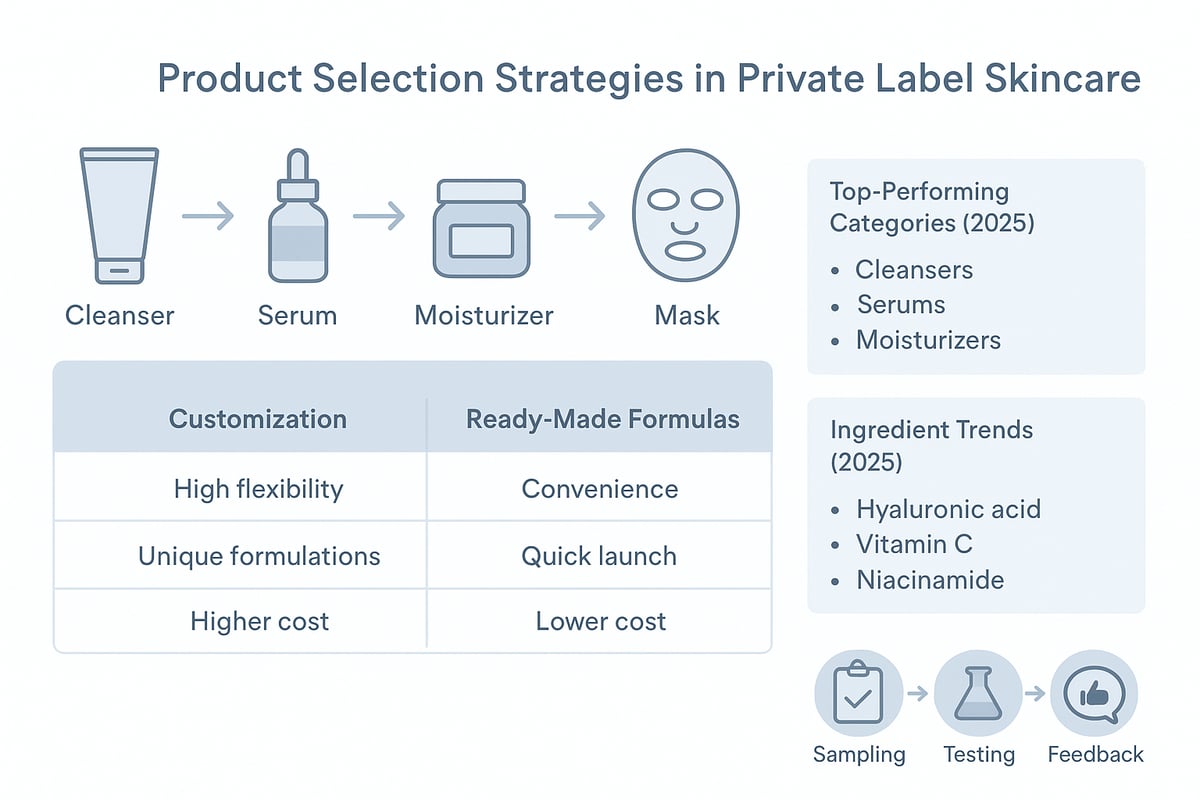
Core Skincare Categories and Best-Sellers
A successful private label skincare line begins with the essentials. Brands typically start with a mix of core products to appeal to a broad audience and build trust.
- Cleansers: Gentle, hydrating, or exfoliating options remain staples.
- Serums: High-performance formulas featuring actives like hyaluronic acid and niacinamide are top sellers.
- Moisturizers: Lightweight gels, nourishing creams, and barrier-repair balms suit various skin types.
- Masks: Sheet masks, clay masks, and overnight treatments offer targeted benefits.
- Eye care: Creams and gels that address puffiness, dark circles, and fine lines.
- Body care: Lotions, scrubs, and targeted treatments for specific concerns.
Ingredient trends in 2025 highlight biotech peptides, CBD, and adaptogens, with a continued focus on clean, fragrance-free formulations. According to recent industry data, serums and moisturizers lead in sales, while limited-edition and seasonal launches drive engagement and urgency.
Customization vs. Ready-Made Formulas
Deciding between custom and ready-made formulas is a pivotal step for private label skincare brands. Both options offer unique advantages, depending on your goals and resources.
| Option | Pros | Cons |
|---|---|---|
| Custom | Unique, tailored to your brand vision; higher perceived value; full control over actives and scent | Higher MOQs, longer lead times, more R&D investment |
| Ready-Made | Faster to market; lower MOQs; proven efficacy; cost-effective | Less differentiation; limited customization options |
Custom formulations work best when you have a distinct concept, a defined market, or need to address a specific skin concern. Ready-made formulas suit brands prioritizing speed, lower risk, or testing new ideas before scaling. Balancing speed-to-market with brand identity is key for long-term success in private label skincare.
Testing and Sampling Before Launch
Sampling is a crucial phase in private label skincare development. Before committing to a full launch, brands should obtain sample kits from manufacturers to evaluate product quality, texture, scent, and performance.
Gathering feedback from a test group, ideally your target audience, uncovers real-world insights and potential improvements. This iterative approach helps refine formulations, packaging, and messaging.
Brands that prioritize thorough sampling and testing are better equipped to deliver products that resonate with consumers and reduce costly post-launch revisions. For a deeper look at the importance of this step, explore this guide on Sampling in skincare product development.
Building a Standout Brand: Marketing & Distribution
Standing out in the competitive private label skincare market in 2025 requires more than just high-quality products. Brands must craft a compelling identity, connect with customers, and master distribution channels to thrive. Let us explore how you can build a powerful presence and drive lasting growth.
Branding, Storytelling, and Community Building
Branding is the first impression your private label skincare business makes. A strong brand story and mission set the foundation for customer loyalty. Begin by defining your brand’s values, voice, and vision. Visual identity, including logo, color palette, and packaging, should reflect these ideals consistently across every touchpoint.
Community building is now essential. Engage with your audience through social media, email newsletters, and events. Encourage user-generated content and reviews to foster trust and credibility. Brands that excel in storytelling, such as those highlighted in Beauty products private label insights, create emotional connections that turn customers into advocates.
To make your private label skincare brand memorable, focus on authenticity and transparency. Share behind-the-scenes content and highlight your team, sourcing, or sustainability efforts. This approach not only attracts attention but also builds lasting relationships.
Go-to-Market Strategies and Sales Channels
Choosing the right sales channels can define the success of your private label skincare brand. Decide whether to focus on direct-to-consumer (DTC), retail, or professional distribution through salons and spas. Each channel offers unique advantages and challenges.
Online marketplaces and subscription models are increasingly popular for private label skincare. They provide access to broader audiences and predictable revenue streams. Wholesale partnerships with salons, clinics, and other beauty professionals can boost credibility and visibility.
Consider data-driven strategies to evaluate channel performance. Analyze customer preferences and adapt your distribution mix accordingly. Flexibility is key, as the private label skincare landscape continues to evolve rapidly in 2025.
Digital Marketing and Influencer Partnerships
Digital marketing is the engine that drives modern private label skincare brands. Invest in SEO and content marketing to increase organic visibility. Share educational blog posts, skincare tips, and product guides to establish authority and attract search traffic.
Social media is a powerful tool for engagement and brand awareness. Collaborate with influencers and micro-influencers for authentic promotion. User-generated content, such as customer reviews and testimonials, can amplify trust and social proof.
Encourage customers to share their experiences online, using branded hashtags or participating in challenges. This not only strengthens your brand community but also expands your reach. In 2025, successful private label skincare brands leverage a blend of digital strategies to remain top of mind.
Navigating Challenges and Ensuring Long-Term Success
Launching a private label skincare brand is only the beginning. Sustaining growth and overcoming industry challenges require careful planning, adaptability, and a commitment to excellence. By addressing common obstacles and embracing innovation, brands can secure a lasting position in the ever-evolving skincare market.
Common Pitfalls and How to Avoid Them
Even the most promising private label skincare ventures can face setbacks if they overlook foundational risks. Quality control is a top concern—work closely with your manufacturer, set clear specifications, and conduct regular batch testing to maintain consistency.
Supply chain disruptions can impact ingredient availability or lead times. Build relationships with multiple suppliers and maintain a safety stock to buffer against delays. Regulatory compliance is another major hurdle. Stay updated on evolving requirements in your target markets and invest in proper labeling and documentation.
Managing customer expectations is crucial. Transparent communication about product benefits, limitations, and timelines can prevent misunderstandings. Below is a summary of key pitfalls and solutions:
| Pitfall | Solution |
|---|---|
| Quality inconsistency | Regular audits, sample checks |
| Supply chain delays | Multiple suppliers, safety stock |
| Regulatory issues | Ongoing compliance review, expert input |
| Customer dissatisfaction | Set clear expectations, gather feedback |
Anticipating and proactively addressing these challenges strengthens your private label skincare business from the start.
Scaling Up: From Startup to Established Brand
As your private label skincare brand gains momentum, scaling up becomes the next milestone. Start by forecasting inventory needs and optimizing fulfillment processes. Efficient logistics reduce costs and improve customer satisfaction.
Expanding your product lines is a smart way to capture new market segments. Analyze sales data to identify best-sellers and emerging trends, then introduce complementary items. Entering new geographic markets can also drive growth, but ensure you research local regulations and consumer preferences first.
Building strategic partnerships is invaluable. Collaborate with established distributors, retailers, or clinics to broaden your reach. Successful brands often attribute their rapid expansion to strong partnerships and robust supply chain networks.
A real-world example: Brands that scaled sustainably prioritized operational efficiency and maintained a focus on quality, even as order volumes increased. This balance is essential for long-term success in private label skincare.
Innovation and Staying Ahead of the Curve
Continuous innovation sets thriving private label skincare brands apart from the competition. Monitor industry trends, such as the adoption of AI-driven product customization and advanced formulation techniques. Investing in R&D ensures your offerings remain relevant and appealing to modern consumers.
Technological advancements are transforming manufacturing processes. According to 2025 Skincare OEM Trends: Custom Formulations to AI-Driven Manufacturing, brands leveraging automation and personalized solutions are better positioned to capture evolving demand.
Consumer feedback is another valuable resource. Use reviews, surveys, and social listening tools to gather insights and refine your products. Staying agile and responsive to change guarantees your private label skincare brand remains at the forefront of the industry.
Resources and Next Steps for Aspiring Private Label Skincare Brands
The journey to building a successful private label skincare business continues well after launch. Having the right resources and a clear roadmap is essential for navigating growth, compliance, and ongoing innovation. Below, you will find expert guidance, practical tools, and actionable steps to help you move forward with confidence.
Selecting the Right Partners and Tools
Choosing the right partners lays the foundation for private label skincare success. Start by exploring reputable manufacturer directories, paying close attention to certifications, minimum order quantities, and production capabilities. Look for partners who offer transparency and robust support services.
Industry tools can streamline market research, branding, and digital marketing efforts. Platforms for trend analysis, packaging design, and e-commerce can save time and help you stay ahead. Networking with industry associations opens doors to insider knowledge and potential collaborations.
For a deeper understanding of current market opportunities, review Private Label Cosmetics Market Growth & Trends, which provides up-to-date data on market size and projections.
Financial Planning and Investment
Financial discipline is vital in private label skincare. Begin by creating a comprehensive budget that covers product development, branding, marketing, and inventory. Factor in ongoing operational costs and plan for unexpected expenses.
Consider your funding options carefully. Some entrepreneurs self-fund, while others pursue loans or attract investors. Calculating profit margins and setting retail prices strategically will ensure your business remains viable and competitive.
Use financial planning tools to model different scenarios and forecast cash flow. A detailed budget helps you make informed decisions and scale your private label skincare business sustainably.
Ongoing Education and Industry Insights
Continuous learning is key to maintaining your edge in private label skincare. Attend trade shows and webinars to discover new formulations, packaging innovations, and business strategies. Subscribing to industry publications will keep you updated on market shifts and regulatory changes.
Online courses and certification programs can expand your technical and business knowledge. Staying informed about international trends is crucial, especially as global influences like South Korea continue to shape the beauty landscape. Read more about South Korea's Impact on the Global Beauty Market to understand how K-beauty is driving innovation and consumer demand.
Actionable Checklist for Launching a Private Label Skincare Brand
Use this actionable checklist to guide your private label skincare launch from start to finish:
| Step | Milestone | Timeline |
|---|---|---|
| 1 | Conduct market research and identify your niche | Weeks 1–2 |
| 2 | Select private label skincare manufacturer and request samples | Weeks 2–4 |
| 3 | Finalize product selection, customization, and packaging | Weeks 4–6 |
| 4 | Ensure regulatory compliance and product testing | Weeks 6–8 |
| 5 | Develop branding, website, and marketing materials | Weeks 8–10 |
| 6 | Plan launch strategy and secure distribution channels | Weeks 10–12 |
| 7 | Launch your private label skincare brand | Week 12+ |
Track each milestone, adjust timelines as needed, and revisit your checklist regularly to stay on course. This structured approach increases your chances of a successful launch.
Frequently Asked Questions (FAQ)
What is the minimum order quantity for private label skincare?
MOQs vary by manufacturer and product type. Always clarify this early to align with your budget.
How long does it take to launch a private label skincare line?
Typical timelines range from three to six months, depending on customization, regulatory approvals, and supplier lead times.
Can I customize formulas and packaging?
Most manufacturers offer both ready-made and custom options. Customization may require higher MOQs and longer timelines.
What are the compliance essentials?
Ensure all products meet local and international regulations. Ingredient transparency and proper labeling are non-negotiable.
What if I am new to private label skincare?
Start small, test your market, and leverage available resources. Engage with industry networks and seek mentorship to avoid common pitfalls.
With these resources, you are equipped to take the next step in your private label skincare journey.
After exploring the evolving landscape of private label skincare in 2025, you now have the insights to carve out your own unique space in this booming industry. Whether you’re an entrepreneur dreaming up your first product or a brand aiming to stand out with innovative, eco-friendly formulas, the next step is all about turning your vision into reality. At The INCI Lab, we’re here to guide you from concept to creation, ensuring you retain full ownership and receive expert support every step of the way. Ready to take your ideas from inspiration to launch? Start Your Product Journey



